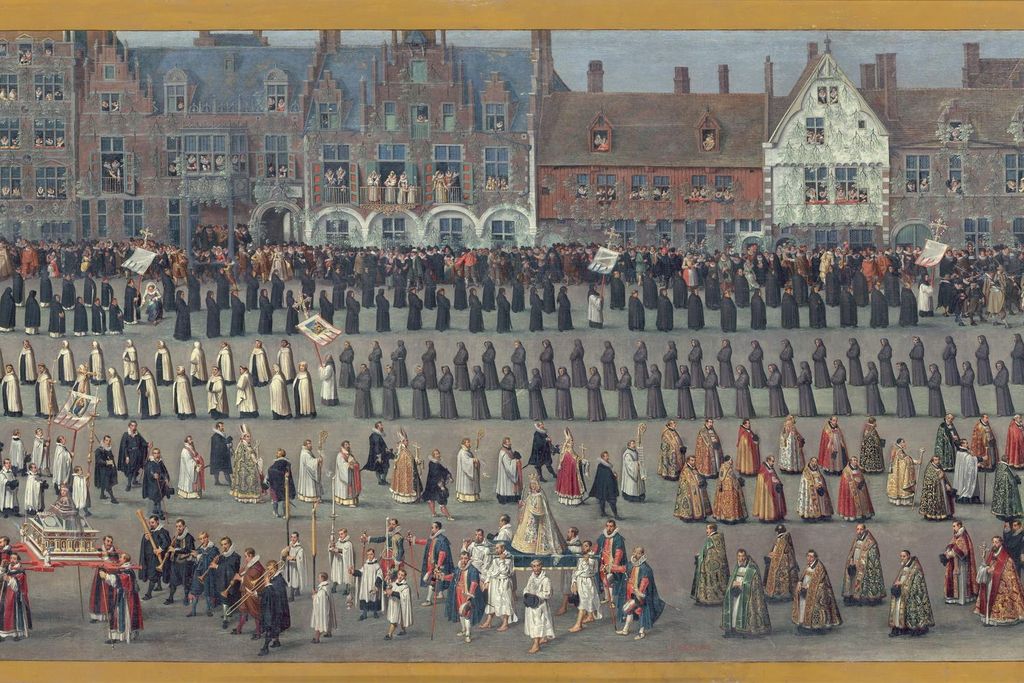How Many People Are in This Painting? The Prado Museum Is Using A.I. to Find Out
Art Meets Science
How Many People Are in This Painting? The Prado Museum Is Using A.I. to Find Out
With the help of a tech start-up, the Madrid museum is enlisting technology to quantify large crowds in its artworks and boost visitor engagement
Celebration of the Ommegang in Brussels: The Procession of Our Lady of the Sablon, Denis van Alsloot, 1616
Public domain via Wikimedia Commons
As legend has it, the young woman who would become St. Ursula set out from her native England in the fourth century to journey across the European continent. The reasons for her travels—whether to marry a man at her father’s behest or to undertake a pilgrimage to Rome—are hazy. But one vivid, if unlikely, detail has endured: Her traveling companions were some 11,000 virgins.
Despite their numbers, the journey was ill-fated. When the group of thousands arrived in Cologne, Germany, all perished at the hands of the Huns.
Saint Ursula With the 11,000 Virgins, painted by an unnamed artist known as the "Master of the 11,000 Virgins" around 1490
Prado Museum
Ursula’s legacy has lived on in sainthood. Her legions of virgins have lived on in the arts. One painting, St. Ursula With the 11,000 Virgins, created around 1490, was so striking that its unknown painter has been dubbed the “Master of the 11,000 Virgins.” But take a closer look at the painting, which hangs in the Prado Museum in Madrid, and try to count all 11,000 virgins supposedly depicted. You’ll either lose count or be bitterly disappointed. The so-called “Master of the 11,000 Virgins” painted only 139.
That tally is the result of the Prado’s new artificial intelligence-powered initiative: Called “Counting the Prado,” the program is a joint effort by the museum and Sherpa.ai, a Spanish A.I. start-up that has “developed an algorithm capable of identifying and counting objects and people in a selection of artworks,” according to a statement.
For a painting like St. Ursula With the 11,000 Virgins, counting to 139 is not an impossible task for a focused human. But take a look at Celebration of the Ommegang in Brussels: Procession of the Guilds and Celebration of the Ommegang in Brussels: The Procession of Our Lady of the Sablon, both painted by the Flemish artist Denis van Alsloot in 1616.
In a new survey created by the Prado, the museum asks its visitors which painting has more characters. At a quick glance, both feature large crowds. But with a headcount of 1,761, the Procession of the Guilds has more people.
For the Prado, these puzzles are built for social media engagement, encouraging viewers to study details and quantities that our eyes would usually skim over, per Artdaily.“Parades, triumphal entries, landings [and] festivities” are precisely the kinds of events that its A.I. model is built to count, as Sherpa.ai explains it in the statement. The purpose of the project is “bringing the museum’s collection to life in a creative and universal way by identifying details in a selection of artworks where quantity, repetition or crowding are essential to the subject depicted.”
For years, the Prado has been at the forefront of enlisting A.I. to increase the accessibility of its collections. In 2019, for instance, the museum began using A.I. to provide more background information about various artworks. Officials hoped these efforts would help non-expert viewers achieve “maximum comprehension” by creating a “multi-layered timeline” that could be personalized according to the viewer’s background knowledge, per a statement.
Elsewhere, art historians are using A.I. for more experimental purposes, such as recreating lost masterpieces. In comparison, the Prado’s goals are rather straightforward. “Our brains are adept at subitizing, or rapidly and accurately perceiving the number of items in a set, but only up to a point,” Sarah Cascone writes for Artnet. “Why not ask A.I. to help?”
Get the latest stories in your inbox every weekday.


